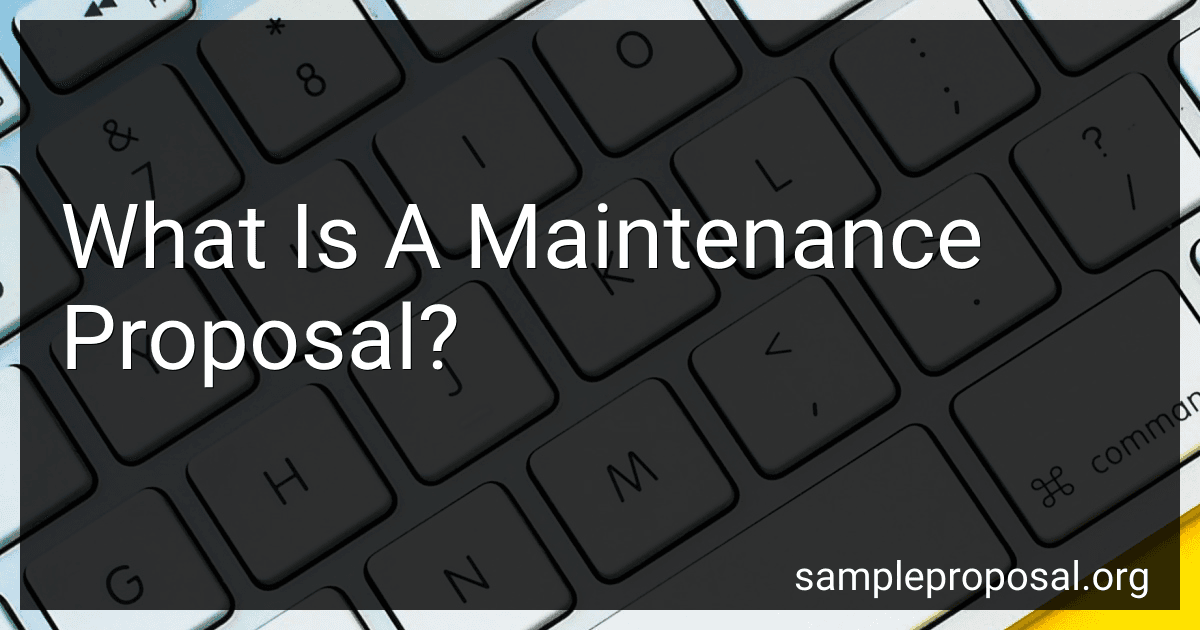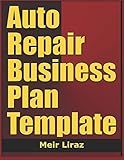Best Maintenance Proposals to Buy in January 2026
A maintenance proposal is a document that outlines the scope of work for ongoing maintenance services for a property or equipment. It typically includes details such as the frequency of maintenance visits, the tasks that will be performed during each visit, the estimated cost of the maintenance services, and the duration of the maintenance contract. Maintenance proposals are commonly used by maintenance companies or contractors to provide potential clients with a clear understanding of the maintenance services that will be provided and the associated costs. Ultimately, a maintenance proposal serves as a formal agreement between the maintenance provider and the client, outlining the responsibilities of both parties in maintaining the property or equipment in good working condition.
How to format a maintenance proposal?
- Title Page: Include the title of the proposal, the name of your company, the date, and the contact information for the client and your company.
- Executive Summary: Provide a brief overview of the maintenance services you are proposing, the scope of work, and the benefits for the client.
- Introduction: Introduce your company, experience, and credentials. Explain why your company is the best choice for providing maintenance services.
- Scope of Work: Clearly outline the maintenance services you will provide, including the frequency of maintenance visits, the tasks to be performed, and any special requirements or considerations.
- Methodology: Explain your approach to completing the maintenance work, including the tools, techniques, and equipment you will use.
- Timeline: Provide a timeline for completing the maintenance work, including start and end dates for each maintenance visit.
- Pricing: Break down the costs associated with the maintenance services, including any materials, labor, and equipment. Clearly state your pricing structure and any additional fees that may apply.
- Terms and Conditions: Include any terms and conditions that apply to the maintenance services, such as payment terms, cancellation policies, and warranties.
- Testimonials or Case Studies: Include any relevant testimonials or case studies from past clients to demonstrate your track record of success.
- Conclusion: Summarize the key points of the proposal and reiterate why your company is the best choice for providing maintenance services.
- Contact Information: Provide your contact information for any questions or further discussion.
- Attachments: Include any additional supporting documents, such as certifications, licenses, or insurance information.
Overall, make sure your proposal is well-organized, clear, and professional in appearance to make a strong impression on the client.
How to customize a maintenance proposal for different clients?
- Understand the client's specific needs and requirements: Before creating a maintenance proposal for a client, it is important to have a thorough understanding of their unique needs and requirements. This may include the size and type of facility they have, the equipment they use, and any specific maintenance challenges they may be facing.
- Tailor your services to meet the client's needs: Based on the information you have gathered about the client's needs, tailor your maintenance services to meet those specific requirements. This may include modifying the frequency of maintenance visits, the types of services provided, and the methods used to complete the work.
- Highlight your experience and expertise: In your proposal, highlight your experience and expertise in providing maintenance services to clients in similar industries or with similar requirements. This will help build trust with your potential client and demonstrate that you have the knowledge and skills needed to effectively meet their needs.
- Include pricing options: When customizing a maintenance proposal for different clients, it is important to include pricing options that are tailored to fit their budget and financial constraints. This may include offering different levels of service or payment plans to accommodate their specific needs.
- Be flexible and willing to negotiate: Finally, be flexible and willing to negotiate with the client to ensure that the maintenance proposal meets their needs and expectations. This may involve making adjustments to the proposed services or pricing structure to better align with the client's preferences.
By following these steps, you can effectively customize a maintenance proposal for different clients and increase your chances of securing new business.
How to align a maintenance proposal with the client's budget and requirements?
- Understand the client's budget: Before creating a maintenance proposal, it's important to have a clear understanding of the client's budget constraints. Ask the client about their budget expectations and limitations so that you can tailor the proposal to fit within those parameters.
- Prioritize requirements: Work closely with the client to identify their most critical maintenance requirements. By prioritizing these requirements, you can ensure that they are included in the proposal while also staying within the client's budget.
- Offer flexible pricing options: Be prepared to offer different pricing options to the client based on their budget and needs. This could include a tiered pricing structure or different service packages that align with the client's requirements.
- Provide cost-saving solutions: Look for ways to optimize the maintenance proposal to reduce costs without sacrificing quality. This could include using cost-effective materials, streamlining maintenance processes, or offering discounts for bundled services.
- Communicate effectively: Clearly communicate with the client throughout the proposal process to ensure that their budget and requirements are being addressed. Be open to feedback and willing to make adjustments to the proposal as needed to align with the client's expectations.
- Be transparent: It's important to be transparent about the costs and services included in the maintenance proposal. Clearly outline the scope of work, pricing, and any potential additional costs so that the client has a full understanding of what they are paying for.
- Provide alternatives: If the initial proposal does not align with the client's budget, be prepared to offer alternative solutions or options. This could include prioritizing certain maintenance tasks, adjusting the scope of work, or exploring different pricing structures.
By following these steps and working closely with the client, you can align your maintenance proposal with their budget and requirements to create a proposal that meets their needs while also staying within their financial constraints.
What is the purpose of a maintenance proposal?
A maintenance proposal is a formal document that outlines a plan for performing maintenance services on a particular asset, property, or facility. The purpose of a maintenance proposal is to communicate the scope of work, schedule, cost, and other important details related to the maintenance project to the client or decision-makers. It serves as a written agreement between the maintenance provider and the client, ensuring that both parties have a clear understanding of the maintenance services to be performed and the expectations for the project. Additionally, a maintenance proposal can help establish a framework for budgeting, scheduling, and tracking the progress of the maintenance work.
What is the timeline for implementing services outlined in a maintenance proposal?
The timeline for implementing services outlined in a maintenance proposal can vary depending on the scope of work and the specific needs of the client. However, a typical timeline for implementing services in a maintenance proposal may include the following steps:
- Initial assessment and planning: This phase involves assessing the current maintenance needs of the client's facility and developing a detailed plan for the proposed services. This typically includes conducting site visits, reviewing equipment and systems, and identifying specific maintenance tasks to be completed.
- Preparation and procurement: Once the plan is finalized, the next step is to prepare for implementation by securing any necessary materials, equipment, or personnel needed to complete the work. This may include ordering parts, scheduling maintenance staff, and coordinating with other service providers.
- Implementation: The actual implementation of the maintenance services can begin once all necessary preparations have been made. This may involve conducting routine maintenance tasks, repairing equipment or systems, or performing upgrades as outlined in the proposal.
- Monitoring and evaluation: Throughout the implementation process, it is important to regularly monitor the progress of the work and evaluate the effectiveness of the services being provided. This may involve conducting inspections, tracking maintenance schedules, and soliciting feedback from the client.
- Completion and follow-up: Once the maintenance services outlined in the proposal have been completed, a final inspection and evaluation should be conducted to ensure that all work meets the client's expectations. Any outstanding issues should be addressed promptly, and follow-up services may be scheduled as needed.
Overall, the timeline for implementing services outlined in a maintenance proposal can typically range from a few weeks to several months, depending on the complexity of the project and the availability of resources. It is important to regularly communicate with the client throughout the process to ensure that timelines are being met and that expectations are being managed effectively.
How to track the success rate of maintenance proposals?
Tracking the success rate of maintenance proposals involves monitoring and analyzing the outcomes of each proposal that is submitted. Here are steps to track the success rate of maintenance proposals:
- Keep a record of all maintenance proposals that are submitted, including details such as the date of submission, the client or department requesting the maintenance, the nature of the maintenance required, and any cost estimates provided.
- Track the outcome of each proposal, noting whether the proposal was approved or rejected, and the reasons for the decision.
- Calculate the success rate by dividing the number of approved proposals by the total number of proposals submitted, and multiplying by 100 to get a percentage.
- Analyze the data to identify trends and patterns, such as which types of maintenance proposals are more likely to be approved, and which factors are most influential in the decision-making process.
- Use this data to make improvements to future maintenance proposals, such as adjusting pricing or service offerings, targeting specific clients or departments, or highlighting the benefits of maintenance services.
- Continuously monitor and track the success rate of maintenance proposals over time to see if any changes or improvements have had an impact on the overall success rate.
By following these steps, you can effectively track the success rate of maintenance proposals and use this data to improve your proposal process and increase your chances of approval.



